IP67 Lightweight Handheld Design For MESH Networking In Harsh Environments
2Watts×2 RF Out , 10/6 Hours Or More Battery Life, Cool Design
Rich Interface, Built-In Network Port, Serial Port, High Fidelity (G.722) Intercom Call
Long Distance, High Speed, Flexible Networking, Strong Anti-Interference Ability
MimoMesh Handheld Radio
Description
Broadband wireless mesh radio is the best choice for point-to-point, point-to-multipoint integrated services communication, which is consisted of a centerless, distributed, self-forming, self-adapting and self-healing dynamic routing/multi-hop relay communication mesh network. And the broadband mesh radio can achieve dynamic routing, multi-hop relay HD video, multi-channel data and fidelity voice between different nodes of the same network in complex applications, such as fast displacement, non-line-of-sight and electromagnetic interference.
Based on fifth-generation mobile communication (5G)/ software defined radio (SDR) technology for multi-carrier modulation OFDM, smart antenna MIMO and mobile Ad Hoc network MANET, MimoMesh is the most powerful mesh radio recently, which can provide real-time HD video, multi-channel data, push to talk voice and broadband Ethernet connection with 100Mbps transmission rate and distance of 50KM or more. It is ideal choice for wireless communication in critical private networks.
MimoMesh wireless broadband MESH, fully ip-based design, flexible installation and use, convenient operation and maintenance, provide video extension and WIFI/4G routing extension. It can be flexibly applied to military communication private network, public safety private network, emergency communication private network, industry information private network, regional Broadband Private network, wireless monitoring private network, cooperative management private network and intelligent transmission private network. For military communications, counter-terrorism, public security law enforcement, security activities, emergency rescue, fire command, forest fire prevention, forestry monitoring, civil air defense/earthquake, electric power patrol, digital oilfield, UAV fleet interchange, fleet formation, maritime communications, airport ground service, subway emergency, highway construction, hydrological monitoring, mobile picking and broadcasting, medical and other fields, provide stable, reliable, timely and efficient high-definition video, multi-channel data, clear voice and visual command scheduling.
- Each node radio station is not only an access terminal server, but also a wireless routing relay and Internet gateway.
- Centerless, distributed self-organizing, self-adapting, self-recovering dynamic routing, multi-hop relay star, linear, mesh and hybrid networks
- Support reliable transmission of point-to-point, point-to-multipoint and multipoint-to-multipoint IP network streams, asynchronous data streams, high-definition video, and fidelity voice
- Provides long-distance, high-bandwidth and low-latency transmission in harsh terrain working environments such as non-line-of-sight, fast-moving, and complex interference
The Latest Generation Of MimoMesh Wireless Broadband MESH
Performance:
- Mesh network (self-forming, self-adapting ,self-healing), high-speed throughput
- Non-visual urban construction、jungle multi-path transmission terrain, effective connection
- High-speed movement of ground, water and air, effective connection
- Multiple antenna settings, omnidirectional, high gain orientation or mixing
- GPS/BD and Multicast Support
Advantages:
- Increased 4.5 times coverage in densely populated areas
- Increase the range by 2 times in the visible limit environment
- Increase 2-4 times data transmission rate
- The same communication range and transmission data rate, reducing transmission power by 2 times
Handheld Radio Specifications
| General | |
| Waveform/SDR Platform | Mobile network MANET+MIMO/9361+7Z030 or 7Z100 (maximum 40MHz BW) |
| MIMO Technology | Space-time coding、Receive Diversity、TX /RX beamforming、Spatial multiplexing |
| Receive Sensitivity | -103dBm@5MHz BW |
| Channel Bandwidth | 2.5/5/10/20MHz ,40MHz optional;FDD by dual-antennas with two-frequencys transceiver optional |
| Data Rate | 1-100Mbps(20MHz BW)/180Mbps(40MHz BW) Adaptive,QoS |
| Modulation Mode | TD-COFDM,BPSK/QPSK/16QAM/64QAM/256QAM/1024QAM Adaptive(Fixed setting optional) |
| RF Output Power (Support TPC, transmisson power control) | 2Watts×2 4Watts×2 |
| Single Hop Communication Distance | 100-300 KM (visible), 1-30 KM (urban area) |
| Mode | Distributed without a center Point-to-point/Point-to-multipoint/Multipoint-to-multipoint,Two or three floors Dynamic routing、Multi-hop relay, Star/Line/Network/Hybrid |
| Single Hop Delay | Average 7mS(20MHz BW) |
| Encryption | DES, AES128/256,Chip /TF card encryption customized |
| Anti-jamming Mode | Manual spectrum scanning channel selection, Full band Intelligent frequency channel Selection/Full band Autonomous frequency hopping/Roaming mode optional |
| Local/Remote Management | Operating frequency, channel bandwidth, network ID, transmit power and other parameter settings, spectrum scanning, real-time display and statistical records of network topology, link field strength signal-to-noise ratio, upload and download traffic,node distance,GPS/Beidou electronic map, temperature/voltage/jamming Monitoring, software upgrade.Remote silence and wake-up options |
| Others | The startup time is less than 28 seconds, and the network access/update/switchover time is less than 1 second.There is no limit on the user capacity of a single system(256 nodes or more) and the number of hops in Mesh networks(Data 15+ hops, voice 10+ hops, video 8+ hops). The total bandwidth loss of multiple hops is less than 70%.Automatic carrier tracking, support over 800 km/h mobile communication |
| Bands(70M-6GHz) | |
| BAND | Frequency range |
| UHF | 430-550/570-700/800-950, 225-400/320-470*MHz |
| L Band | 1000-1200/1300-1500/1600-1800/1800-2000,1200-1700*MHz |
| MIIT | 336-344/512-582/566-626/606-678/1420-1520/1430-1444MHz |
| S Band | 2.0-2.2/2.2-2.5/2.5-2.7/2.7-2.9, 1.6-2.3/1.9-2.7*GHz |
| C Band | 4.4-5.0/5.25-5.85, 4.2-5.2/5.5-6.0*GHz |
| Environmental | |
| Operation Temperature | -40℃ ~+80℃ |
| Protection Level | IP66,IP67/IP68 Customized |
| Mechanical | |
| Size/Weight | 19×6.8×3.8cm/0.769kg(with 11.1V/77.7Wh battery and WiFi Handheld Radio) 22×6.8×3.8cm/0.982kg(with 11.1V/114Wh battery Handheld Radio) 20.5×6.8×3.8cm/0.799kg(with 11.1V/77.7Wh battery and WiFi/HDMI Handheld Radio) 20.7×6.9×5.5cm/1.30kg(with 11.1V/77.7Wh battery and WiFi/HDMI/5G Handheld Radio) 19×6.8×3.8cm/0.789kg(with 11.1V/77.7Wh battery and Display Screen Handheld Radio) |
| Installation/Color | 4 Mounting Holes/Black,Lron Gray、Army Green Optional |
| Power | |
| Supply Voltage | 9-24/12-28VDC (2Watts×2/4Watts×2) |
| Power consumption | Operation 1-2A/Standby 0.4-0.6A@12V (2Watts×2) Operation 2-4A/Standby 0.5-0.7A@12V (4Watts×2) |
| Power Selection | Power Supply by Twist-Lock Battery or Main Cable |
| Batteries | 10/6 hours for 114/77.7Wh |
| Interface | |
| Basic interface | 2xTNC RF, 1-3xRJ45 Ethernet 100/1000BaseT, WiFi AP,RS232/TTL, Sbus/Bluetooth, 1.2-230.4Kbps, DC Input |
| Push to talk/Auxiliary interface | MIC, SP, PTT, GND/1xRS485,1xUSB2.0 OTG |
| Network Extension | 4G-5G Public Network Routing/WB-NB integration /LTE, Satellite, Fiber |
| Video Extension | Low Delay HDMI/SDI/CVBS, 4K/2K/1080P/720P/D1 |
| Link Status Indicator | Steady red – The network is not connected Blinking red – Starting/not connected to the network Steady green – The network is connected Blinking green – Voice PTT is down |
| RSSI Link Indicator | Steady green – The link quality is excellent Blue Steady – The link quality is good Steady yellow – The link quality is medium Steady purple – The link quality is slightly worse Steady red – The link quality is poor or link is down |
| Management Interface/Control Interface | Web-based network management/GUI, API secondary development interface/SNMP |
| OEM | |
| Size/Weight | 10.1×5.4×1.9cm/123.5g |
| RF | SMP |
Model Name:

Accessories: Options:

Significant applications in Non Line of Sight /Multipath Fading environments, video/data/voice critical ommunications:
- Robot / Unmanned Vehicle, Reconnaissance / Surveillance / Anti-Terrorism / Monitoring
- Air-to-air & air-to-ground & ground-to-ground, public safety / special operations
- Urban network, emergency support / normal patrol / traffic management
- Inside and outside the building, fire fighting / rescue and disaster relief / forest / civil air defense / earthquake
- TV broadcast wireless audio / video / live broadcast
- Marine communication / high speed transmission on the opposite side of the ship
- Low deck wireless network / ship landing
- Mine / tunnel / basement connection
Wireless Monitoring Guarantee In Forest Areas
Aiming at the application scenarios of mountain terrain and vegetation coverage in forest areas, fixed nodes are deployed at mountain heights or relative heights in forest areas. They can also be deployed at the same address with public network base stations, which is convenient for installation and power supply. It can also be interconnected with the public network. The equipment does not need to be on duty. By means of self-interconnection and multi-hop relay, the disadvantageous factors of mountain area for wireless signal occlusion are transformed into the relay forwarding of commanding heights. So as to extend the communication distance, expand the coverage, reduce the monitoring dead angle and reduce the construction investment. Then the fire danger data and image information collected by each node equipment can be obtained. Real-time all-day return to forest management command center or satellite communication command vehicle. The remote command center can be transmitted back through the 3G/4G public network, which is convenient for the commander to view in time, scientific analysis.
The vehicle-mounted radio is installed on the satellite communication command vehicle and patrol vehicle, which is convenient for flexible networking with the commanding height fixed radio and patrol personnel. As a first-line command center, it can quickly enter the forest area, facilitate information collection, patrol monitoring and command dispatch, and provide wireless network support for the surrounding patrolmen. It can also interconnect with the satellite communication system and transmit the front-end field information back to the back-end monitoring command center for timely prediction, response and control of the fire situation on the spot.
Small and portable, with long battery life, it is easy for patrollers to carry. Especially when the fixed radio at the commanding height can not cover the area effectively or the vehicle radio can not reach the area, it can go deep into the forest area to carry out a sudden task. It is not only convenient for real-time voice communication with the commanders and other patrolmen on the surrounding vehicles, but also can transmit fire video images collected in the forest area as timely as possible. Provide comprehensive and clear on-site images to commanders at all levels
Through the UAV-mounted image acquisition and the airborne self-organizing network node equipment lifting off, the mobile, efficient and fast accessibility can further expand the wireless coverage, reduce the coverage of blind areas, and improve the quality of video return; at the same time, air mobile monitoring and ground fixed monitoring can be organically combined, complementary advantages, forming a ground-to-air “three-dimensional” monitoring network. Better effective detection of fire detection and real-time monitoring while effectively increasing the visual range of the monitoring area and reducing the dead angle of monitoring

Emergency Rescue Command And Dispatch
After the rescue troops arrived at the rescue scene, in view of the complex and harsh environment in the disaster area, the portable single soldier node with lithium battery and emergency control node can be quickly carried into the disaster area. In the absence of power supply constraints, flexible deployment is required according to the site environment and networking requirements to ensure the completion of emergency wireless broadband private network as soon as possible. Effectively solve the communication problems caused by the damage of power and base station facilities and the inconvenience of other communication systems, and help to open the “last kilometer” of wireless broadband access.
The first-line rescue team members in the disaster area will collect HD video information from the scene and send it back to the rescue command vehicle as far as possible in the golden rescue time through multi-hop relay on the ground or on-board node of UAV. It is convenient for the off-site commander to intuitively control the actual situation of the disaster area, formulate a reasonable plan, and scientifically analyze the rescue. At the same time, taking advantage of UAV’s air superiority in carrying mobile nodes, it can also realize large-scale real-time monitoring, disaster data transmission and harmful gas detection in disaster scene.
Making use of the MESH wireless multi-hop broadband network built on the spot, it integrates and interacts with various heterogeneous cluster private networks. Further broaden the network coverage to meet the voice communication between the underground and the ground of the disaster scene, the depth of the building and the external scene, and the obstruction and blocking. It is convenient for the on-site commander to issue rescue orders in time, and the rescue team can cooperate effectively. At the same time, the system can be interconnected with the rescue vehicle satellite equipment to realize real-time interaction between the front and rear information and unified command and dispatch. In addition, the real-time combat position of all rescue vehicles and external rescuers can be located by GPS and presented in real time on the MESH wireless Mesh radio terminal software.
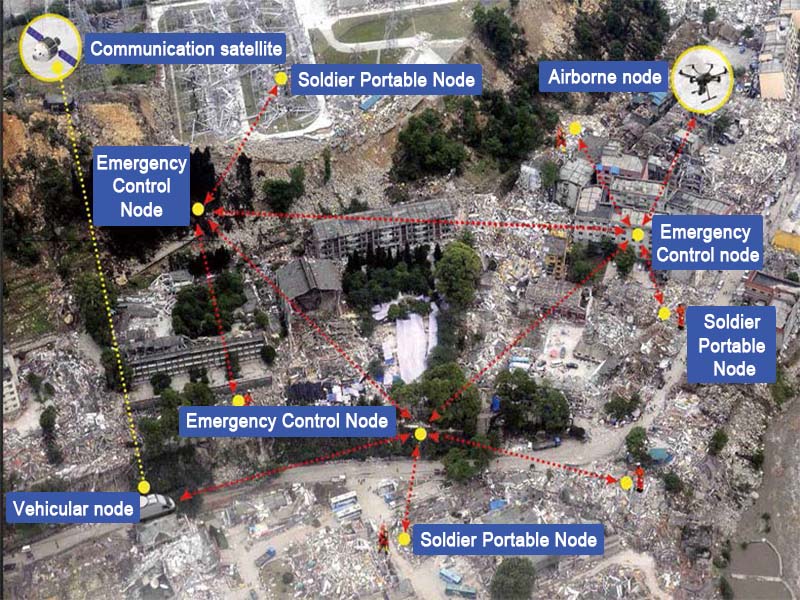
Fire Emergency Communication Command
Fire and rescue sites can quickly deploy different forms of MESH nodes inside and outside the site, and efficiently build up the network. Especially for the complex interior and underground structures of fire buildings, by constructing a wireless multi-hop network, it is possible to effectively solve the problem of poor communication or blind spots due to occlusion. Make sure that “everyone has a net”. Guarantee reliable and timely wireless communication between fire officers and soldiers inside and outside the fire site. At the same time, fire detection and forecasting and real-time fire monitoring can be realized through the mobile nodes carried by fire trucks and UAVs.
The first-line firefighters in the fire field used the “deployment while deploying” approach to the MESH equipment. The collected HD video information in the fire field is transmitted back to the fire engine command center through multi-hop relay. Video storage is also available so that commanders outside the field can control the fire situation intuitively without dead angle in an all-round way, make scientific analysis in time, and quickly issue operational instructions.
MESH system can be connected with 350M narrowband digital trunking system. Effectively solve the voice communication between the underground and the ground of the fire site and between the interior and exterior of the building. Facilitate on-site command of firefighters on-site collaboration, teammates search and rescue and safe evacuation. At the same time, the system can also be interconnected with fire vehicle satellite settings. To realize the remote information exchange between the front fire extinguishing site and the rear command center. Provide strong support for commanders at all levels in scientific decision-making and command.
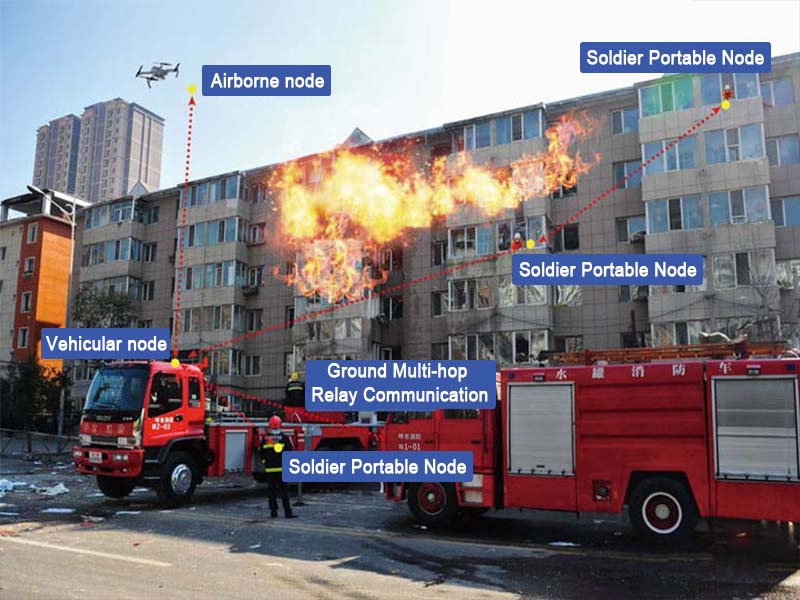
Maritime Communication Of Ship Formation
In view of the marine wireless communication environment, wireless MESH nodes are deployed on board ships. It can quickly build a broadband wireless network with high reliability, high maneuverability, strong anti-destruction and anti-interference, and over-the-horizon transmission. Ensure the flexible networking and multi-hop transmission between ship and ship cabins in the ship formation, and provide users with safe, reliable, stable and timely multimedia integrated transmission services such as voice, data and video.
Support the dynamic networking of ship formations during maritime navigation. The network topology can be quickly reconfigured when the formation changes, and does not affect the wireless communication of the entire formation. Through the wireless multi-hop Mesh radio, the flagship node directs and coordinates the operation and work of the entire fleet. The stern node transmits all kinds of information to the flagship node in time, and can also exchange information with each other. At the same time, the airborne node acts as a motorized high-enhancement coverage node for the entire network, which can further expand the coverage of the network radius while effectively expanding the field of view of the operational radius and provide more comprehensive information for the flagship node. In addition, the flagship node communicates with the remote command center through the mobile satellite system.
Link transmission self-awareness fully guarantees the continuity and fluency of the transmission service. Load balancing effectively improves the efficiency of ship network formation wireless network communication, Anti-jamming capability greatly enhances the electromagnetic confrontation capability of formation maritime operations, invulnerability ensures that wireless networks have a strong vitality. Any single node failure in the network will not affect the operation of the entire formation network, which can be called “unbreakable maritime mobile network”

Fleet Linkage And Self-Connection
Deploying wireless MESH radio station on the vehicle. After power-on, a multi-hop relay, multi-service, high-reliability, high-mobility broadband wireless transmission network can be established in a very short time. Guarantee multi-vehicle simultaneous communication, providing users with independent, safe, efficient and timely voice communication, data transmission and video surveillance services.
Support fleet dynamic networking. When the vehicle randomly enters/exits and the formation changes continuously, the network topology changes rapidly, and is not affected by the formation change of the vehicle formation. The workshops can still maintain normal communication. At the same time, the command car node can perform video surveillance on the interior, front and road conditions of other vehicles. Any video of the captured team can be transmitted back to the remote command center via the mobile satellite system.
The anti-multipath interference capability greatly adapts to the complex and variable wireless transmission environment of the fleet, and ensures reliable communication in the shadowless non-viewing scene through diffraction multipath transmission.

Subway Penetration Wireless Communication
For the underground special environment, in the subway station, through the network topology of chain relay and network, the wireless multi-hop network is rapidly deployed and constructed, relay transmission is relayed, which effectively solves the problem of wireless signal occlusion and realizes the wireless communication between ground and underground.
In the subway application scenario, the traditional network laying maintenance cost is high, and the mobile scalability is poor. The wireless MESH network is easy to deploy, flexible to use, and simple to operate. It can effectively reduce network construction and operation and maintenance costs, and can meet the needs of staff to move freely with tasks. It can also flexibly adjust the deployment of video surveillance nodes to avoid monitoring blind spots.
Centerless, all-IP MESH broadband system self-healing self-connection, network robustness and resistance to destruction, lack of any node, still work properly, It can be used as a coverage extension of the existing wireless communication private network in the subway to realize converged communication, and can also be used as an emergency backup transmission guarantee for the local failure of the operator’s public network in the subway.
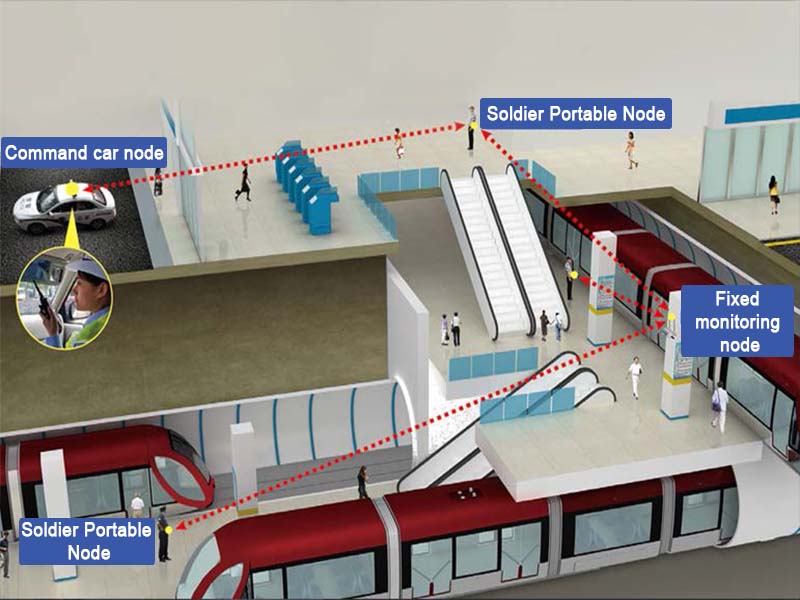
Tactical interconnect self-group control
Different types of AD hoc network nodes belong to each combat unit and can quickly build wireless broadband networks with high reliability, high mobility, strong damage resistance and anti-jamming, and beyond-line-of-sight transmission without relying on any fixed facilities. After the distributed network is powered on, it can quickly and dynamically form a multi-hop self-group network according to the actual battlefield electromagnetic environment. Without the center feature, the whole network can still heal and work normally after a single node device is destroyed.
Through the broadband wireless self-organizing network, the information nodes of each combat unit can realize the information sharing of enemy situation, battlefield situation awareness, real-time military situation consultation, immediate assignment of tasks, and issuing of operational instructions, thus realizing the integration of all combat units and real-time and efficient command.
The all-IP AD hoc network node equipment is interconnected with other heterogeneous communication networks to create an “air heaven and earth” grid military communication network. The command information node comprehensively commands and coordinates the operational tasks of each combat unit, and each participating information node timely uploads and reports the battlefield situation and battle situation. At the same time, the airborne node can be used as the high enhancement coverage node of the wireless AD hoc network system to further expand the battle radius and provide the latest battle situation and situation forecast for each combat unit. In addition, the command information node realizes the front and rear information exchange and sharing through interconnection with the satellite system, and the remote command and control.

City anti-terrorism and stability command
The fixed station node is deployed at the commanding or relative high point of urban buildings. In the case of building occlusion, it can effectively form a self-forming network with the vehicle station and the disposal individual soldier node and communicate with each other. At the same time, as a relay node to enhance or expand the wireless communication distance, the police can collect images at the scene of emergencies and send them back to the rear command center in the first time through multi-hop relay, providing the leaders at all levels with the scene situation and decision-making basis for timely scientific analysis and quick instruction.
The vehicle-mounted node can be deployed on mobile vehicles and is fast and accessible. It can not only be connected with vehicle-mounted wireless network, but also can be connected with the fixed station at the high point and the flexible area for disposal of individual soldiers, so as to build a “three-dimensional” wireless broadband network, which can meet the needs of “static medium communication” and “mobile medium communication” on-site emergency communication. At the scene of an emergency, it can not only serve as a front-line emergency police support center to provide information network and communication support for surrounding individual soldiers, but also serve as a small front-end command center to conduct unified command and scheduling for on-site police disposal.
Emergencies were collected at the same time, also can be the multiplex real-time video back, so that the front-line commander can omni-directional real-time visual control of the scene, but also on the GIS map real-time corresponding disposal of police cars, and disposal of individual movement and position, most likely on top of things, improve the disposal of police collaborative capabilities and operational efficiency. The individual soldier platform is distributed to the law enforcement police on the scene, which is convenient to go into the scene of an emergency or a dense crowd. The high-definition video can be sent back to the command center in time, so that the field commander can intuitively grasp the situation of the scene in real time, and can carry out two-way voice communication with other individual soldiers to achieve efficient local cooperation.

Area coverage key deployment and control
Individual soldiers are equipped with portable nodes, motor vehicles are equipped with vehicle-mounted nodes, and emergency control nodes are quickly deployed in temporary places or street light poles. Wireless self-organizing network is constructed on site in the first time, key control and local coordination of target areas are quickly completed, and command center advance and on-site command and scheduling are effectively realized.
Fixed nodes are set up and deployed on urban high-rise buildings and commanding heights as relay transmission nodes and centralized return points to effectively enhance the regional coverage capacity of the system and form a “mechano-solid hybrid” multi-hop relay with mobile nodes in the front-end target area to ensure the wireless interconnection and information sharing under non-visible and multi-path scenarios.
The centralized return node of the commanding height can finally send the field information of the target area back to the rear command center in time, which is convenient for analysis, judgment and command decision, realizing the real-time interaction of front and rear information and group command linkage.
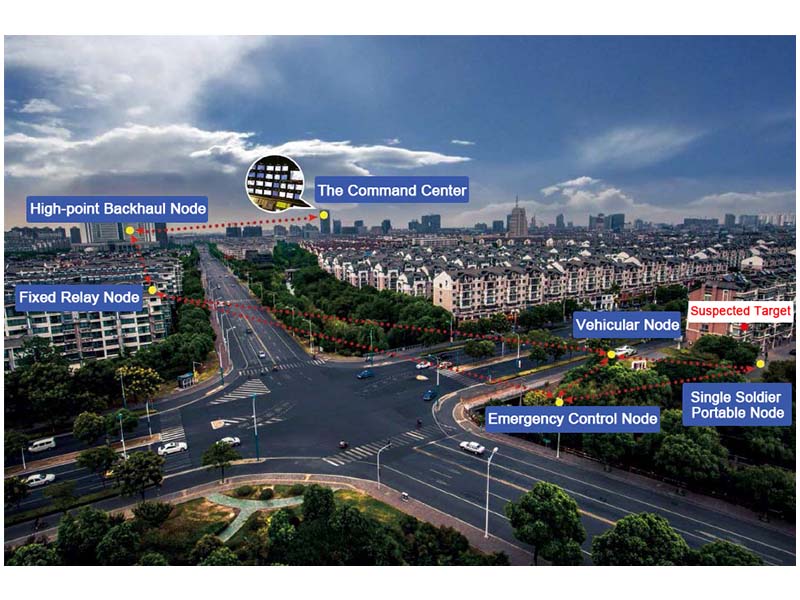
Security patrols for large events
Fixed station nodes can be pre-deployed at fixed monitoring points on the activity site to build wireless self-organizing private networks with on-site security patrol command vehicles and security patrol personnel for efficient interconnection. In each key fixed monitoring position, the collected field image information can be sent back to the field command center and the field security patrol command vehicle in real time through single-hop direct or multi-hop relay mode, so that the commander can perceive the scene dynamic at any time, timely disposal and effective prevention; It can also be used for security patrol personnel to review the video of each monitoring area at any time, so as to grasp the scene situation in time and deal with emergencies at any time.
The vehicle platform is deployed in the on-site security patrol command vehicle, which can be connected with fixed monitoring points and security patrol personnel anytime and anywhere to achieve flexible networking of “static communication” and “mobile communication”. In the event security scene, it can not only maneuver forward as the front command center, which is convenient for the scene command center to effectively expand the coverage of security, avoid covering blind areas, so as to manage the surrounding security patrol personnel in real time. It can also be used as a mobile monitoring patrol node to collect return messages anytime and anywhere, and provide wireless broadband network support for security patrol personnel.
The individual soldier platform is easy for security patrol personnel to carry. In the implementation of patrol tasks, it is convenient for real-time voice communication between commander and security patrol personnel, and efficient local coordination; In addition, the hd video collected on the spot can be sent back to the command center in time to reduce the dead Angle of monitoring.

The radio is first packed into a custom box, and then packed into a carton for delivery.
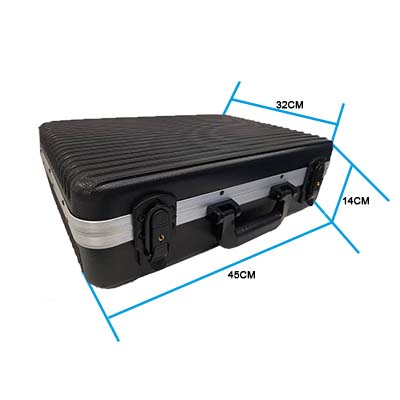
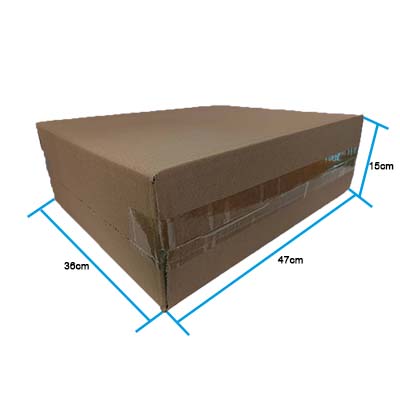


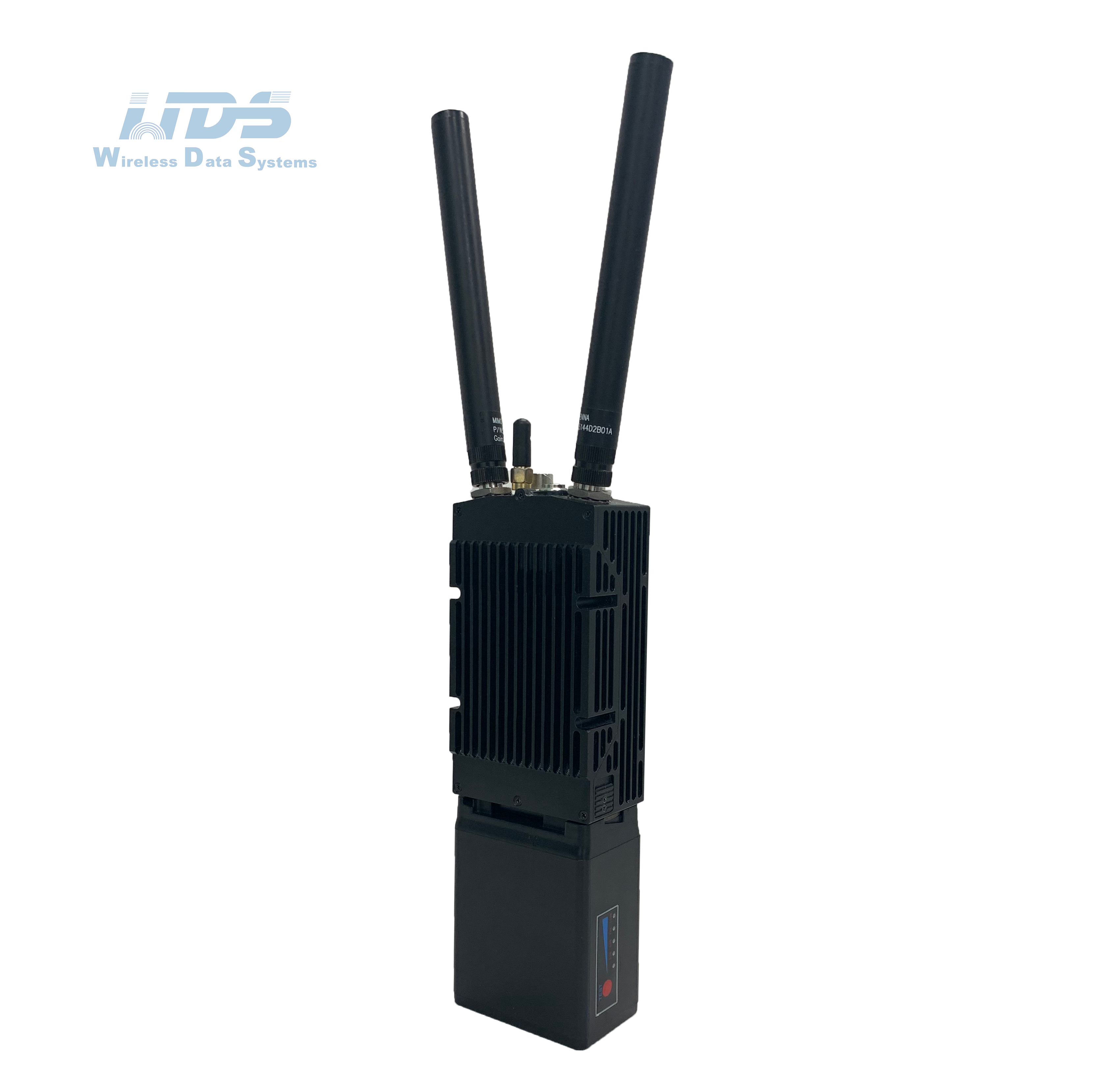


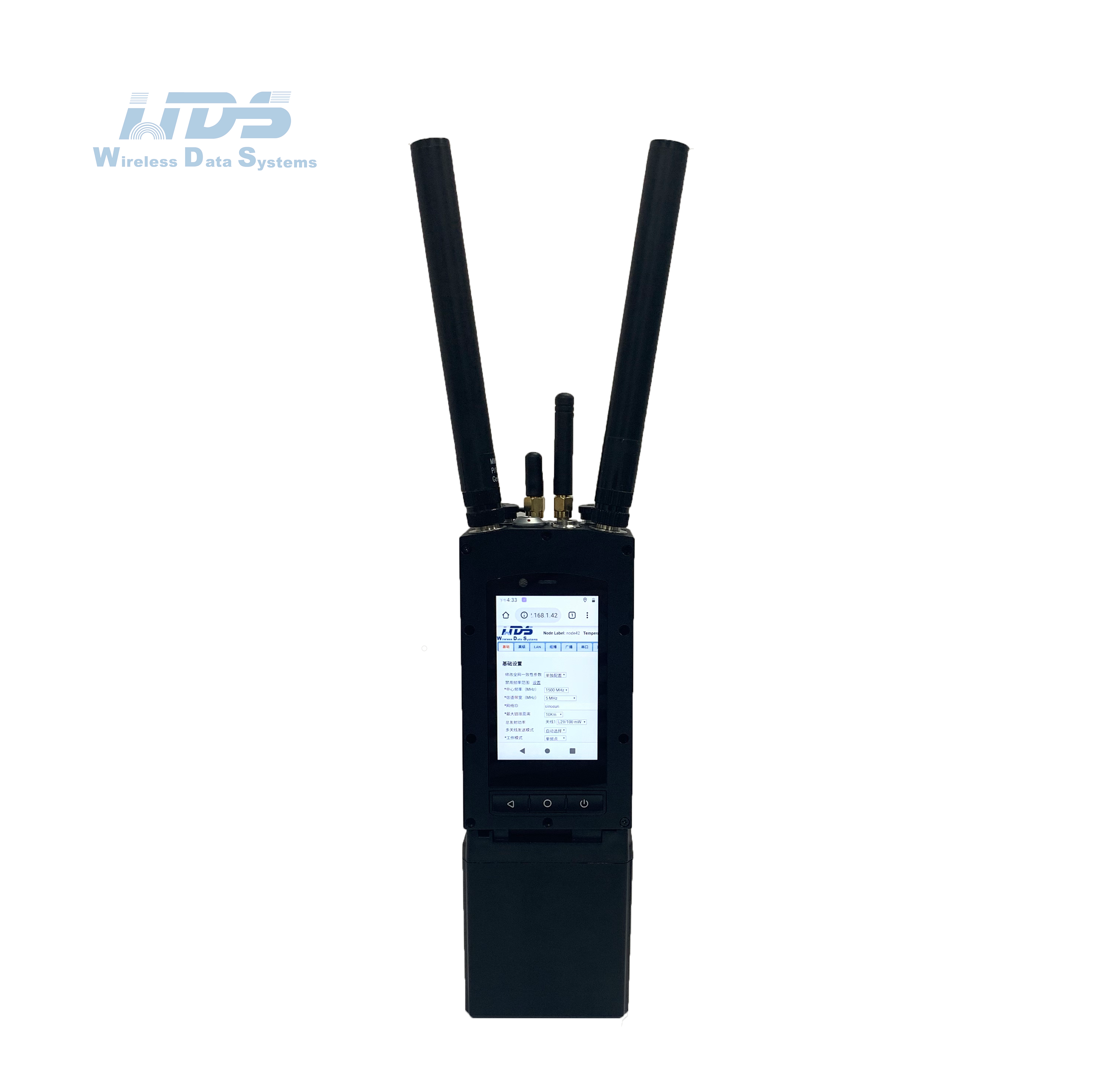


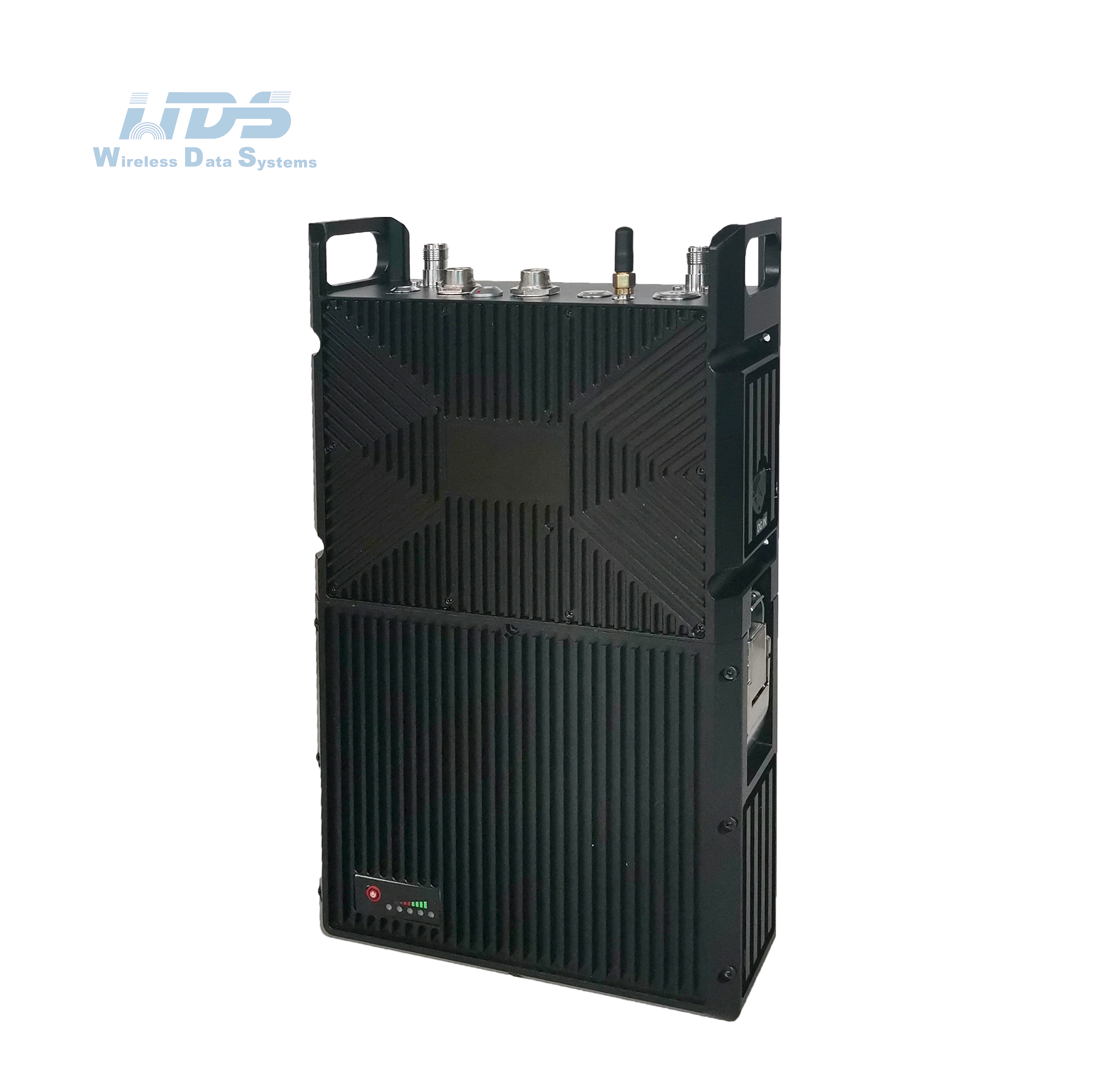

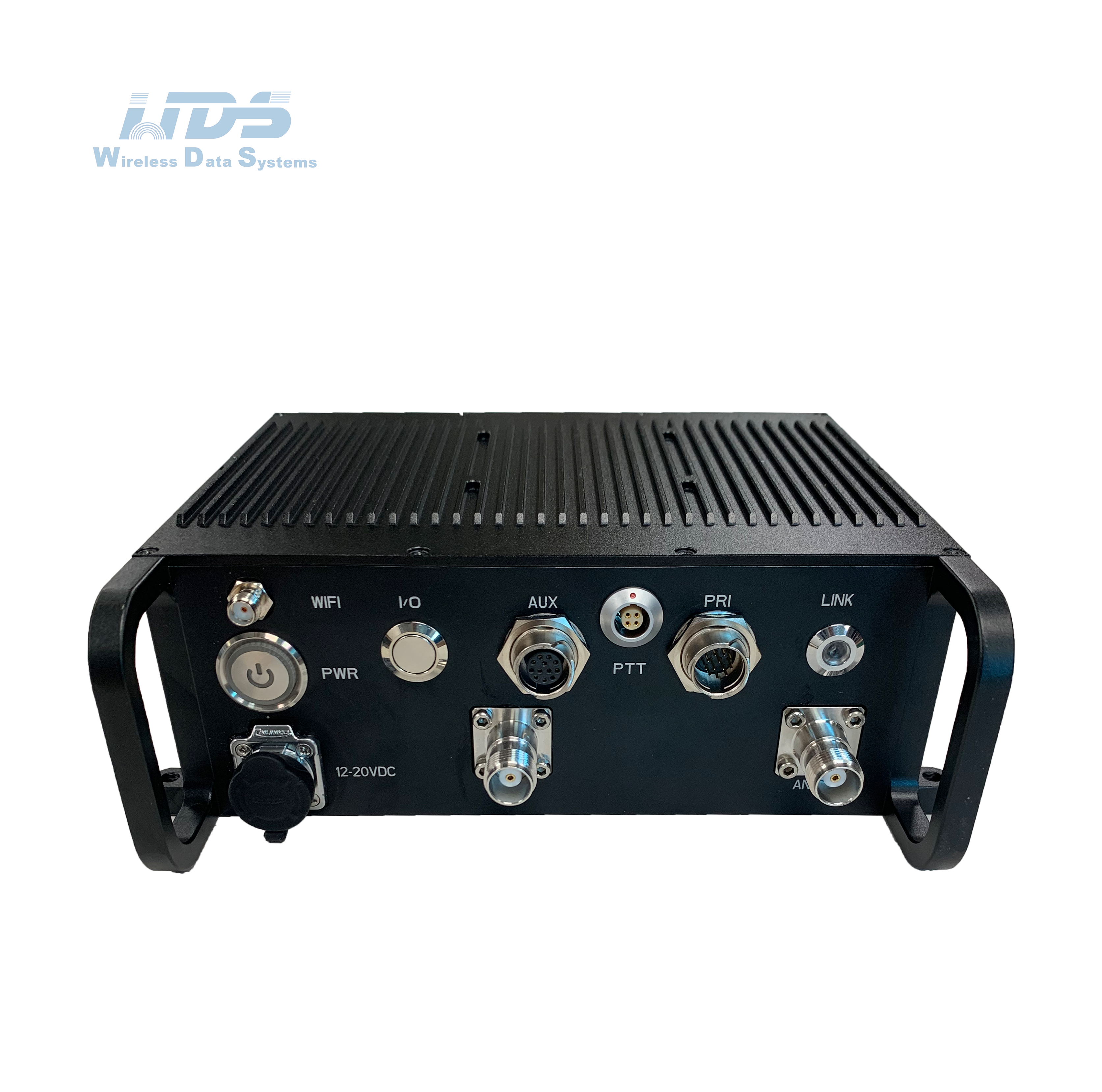



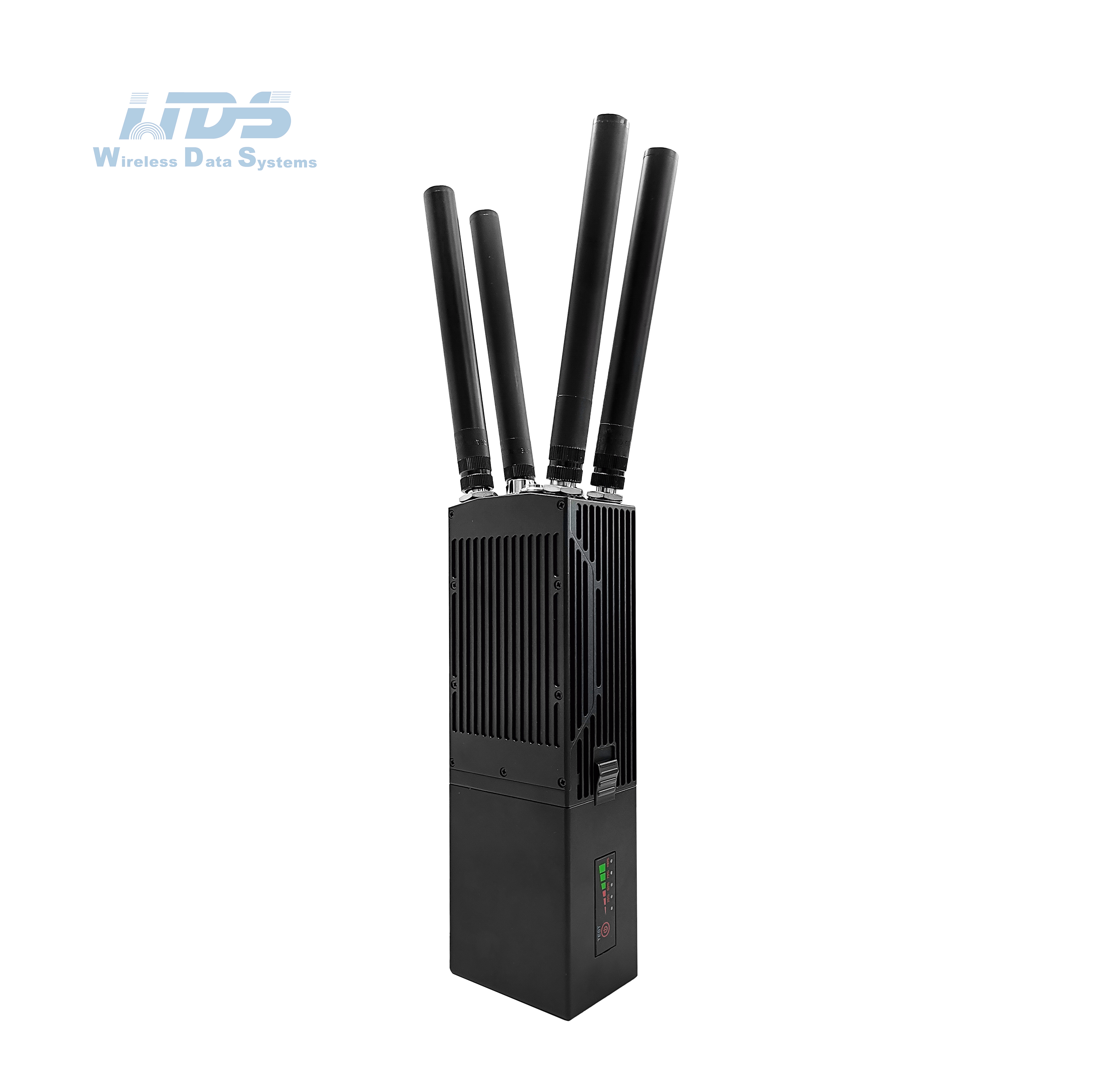

Reviews
There are no reviews yet.